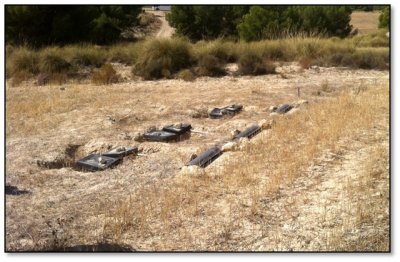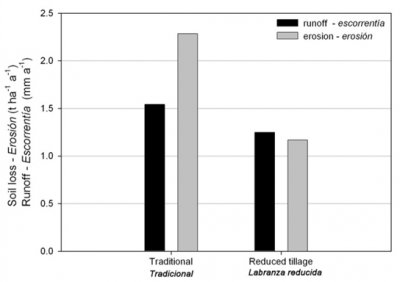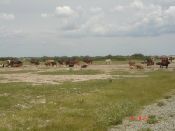|
In the Guadalentín basin in south-eastern Spain, land degradation is considered severe due to a combination of several factors. The semi-arid climate has dry summers followed by intense autumn rainfall, while there is a steep topography and fragile soils. Desertification takes the form of soil erosion and drought. Moreover, considerable land use changes have taken place over the last centuries, which is an important driving force for further degradation in the area. Reduced tillage may improve the soil structure, improve infiltration and reduce runoff and erosion.
Experiments using minimum tillage to reduce runoff
|
The experiment was carried out in a cereal field where minimum tillage was compared with conventional tillage. Under conventional farming practice winter wheat is sown in October-November after the autumn rains. The crop matures in May and harvesting is done in June. Crop residues are left on the field as mulch or for a post-harvest grazing by cattle until September, the fields are then ploughed with a mouldboard plough for seeding in November or left fallow for one year. Under this conventional system, the land was ploughed 5 times in two years, one of which with a mouldboard plough. Under minimum tillage, the land was ploughed only three times in two years with a disc or chisel plough and never with a mouldboard plough. The purpose is to gradually create a more stable soil structure which would reduce runoff and erosion while at the same time increasing available water.
 |
To monitor the effect of the treatments on ecological criteria, three adjacent runoff-erosion plots (Gerlach type, see picture) were installed for the treatment and the reference field, giving a total of 6 runoff plots. To determine the exact contributing areas of the open runoff plots, a terrestrial laser scanner (TLS) was used to construct a high resolution digital elevation model. After every event, runoff and soil loss were measured by collecting the water and sediments from storage tanks. |
To evaluate the economic impact of reduced tillage measures, all farm operation costs of each treatment (ploughing, implementation, seeding, etc.) were registered in a logbook, and the harvest was determined individually per treatment. Unfortunately, since each harvest is followed by a fallow year, only 1 cereal harvest was obtained during the monitoring period.
The results indicated that under reduced tillage there is decrease of soil loss (56%) and water loss (30%) as compared to conventional tillage (see figure below). These data are based on 2 years of monitoring in which 18 events were registered.
It is expected that the reduction in soil and water loss may be higher on the longer term when soil organic matter content in the soil under reduced tillage increases and the soil structure further improves.
The result also shows that the reduced tillage with mulching results in a 12% higher profit due to a reduction in operation costs for ploughing. It is expected that on the longer term, harvest under reduced tillage will increase due to an increasing organic matter content (and fertility) of the soil. |
 |
 |
The results are evaluated from a production, socio-cultural and economic point of view. The bars express the estimated or measured percentage of change with respect to the reference situation. This change can be positive (blue) or negative (red). Note that this evaluation is based on the experiments, on the long term experience of the coordinating team in this area and on consultations with the farmers. |
- Stakeholders were involved from the beginning of the experiment. A demonstration day was organized where stakeholders representing farmers, regional policy makers, NGO’s and scientists discussed and exchanged ideas. The farmers are aware of the land degradation problem and they can make their own experiment or trials in their field for minimising the land degradation problem.
- On the other hand there was no clear advantage from a perspective of yield, although there is some reduced cost with fewer operations. The evaluation shows that the advantage is purely ecological for the moment. More time is needed to show if the clear advantages are permanent.
|
Reduced tillage reduces soil loss (56%) and water loss (30%) as compared to conventional tillage. After the relatively short period (2 years) of monitoring with only 1 harvest, no effect was observed on cereal yield. This may be different after more years of monitoring. Nevertheless, even if yield is not affected by this treatment, a higher benefit was achieved because of lower operational costs under reduced tillage. Longer term monitoring is still required since most soil and water loss occurred during the low frequency high intensity events.
|
|
The results show that there are various opportunities to increase economic benefits and at the same time provide increased ecological services by protecting and maintaining soil and water resources under rainfed agriculture in semi-arid conditions. For these reasons, these measures have a relatively high level of acceptance amongst stakeholders.
|
|







